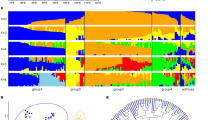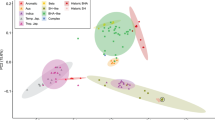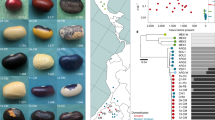Abstract
As early farming spread from the Fertile Crescent in the Near East around 10,000 years before the present1, domesticated crops encountered considerable ecological and environmental change. Spring-sown crops that flowered without the need for an extended period of cold to promote flowering and day length–insensitive crops able to exploit the longer, cooler days of higher latitudes emerged and became established. To investigate the genetic consequences of adaptation to these new environments, we identified signatures of divergent selection in the highly differentiated modern-day spring and winter barleys. In one genetically divergent region, we identify a natural variant of the barley homolog of Antirrhinum CENTRORADIALIS2 (HvCEN) as a contributor to successful environmental adaptation. The distribution of HvCEN alleles in a large collection of wild and landrace accessions indicates that this involved selection and enrichment of preexisting genetic variants rather than the acquisition of mutations after domestication.
This is a preview of subscription content, access via your institution
Access options
Subscribe to this journal
Receive 12 print issues and online access
$209.00 per year
only $17.42 per issue
Buy this article
- Purchase on Springer Link
- Instant access to full article PDF
Prices may be subject to local taxes which are calculated during checkout





Similar content being viewed by others
Accession codes
Primary accessions
NCBI Reference Sequence
References
Zohary, D. & Hopf, M. Domestication of Plants in the Old World 3rd edn. 316pp. (Oxford University Press, New York, (2000).
Bradley, D. et al. Control of inflorescence architecture in Antirrhinum. Nature 379, 791–797 (1996).
Harlan, J.R. & Zohary, D. Distribution of wild wheats and barley. Science 153, 1074–1080 (1966).
Morrell, P.L., Toleno, D.M., Lundy, K.E. & Clegg, M.T. Low levels of linkage disequilibrium in wild barley (Hordeum vulgare ssp. spontaneum) despite high rates of self-fertilization. Proc. Natl. Acad. Sci. USA 102, 2442–2447 (2005).
Kilian, B., Özkan, H., Pozzi, C. & Salamini, F. Domestication of the Triticeae in the Fertile Crescent. in Plant Genetics and Genomics: Crops and Models Vol. 7 (eds. Feuillet, C. & Muehlbauer, G.J.) 81–119 (Springer Science and Business Media, New York, 2009).
von Bothmer, R., Sato, K., Komatsuda, T., Yasuda, S. & Fischbeck, G. The domestication of cultivated barley. in Diversity in Barley (Hordeum vulgare). (eds. von Bothmer, R., Van Hintum, T., Knupffer, H. & Sato, K.) 9–27 (Elsevier, Amsterdam, 2003).
Laurie, D.A., Pratchett, N., Bezant, J.H. & Snape, J.W. RFLP mapping of five major genes and eight quantitative trait loci controlling flowering time in a winter × spring barley (Hordeum vulgare L.) cross. Genome 38, 575–585 (1995).
Oliver, S.N., Finnegan, E.J., Dennis, E.S., Peacock, W.J. & Trevaskis, B. Vernalization-induced flowering in cereals is associated with changes in histone methylation at the VERNALIZATION1 gene. Proc. Natl. Acad. Sci. USA 106, 8386–8391 (2009).
Yan, L. et al. Positional cloning of the wheat vernalization gene VRN1. Proc. Natl. Acad. Sci. USA 100, 6263–6268 (2003).
Yan, L. et al. The wheat VRN2 gene is a flowering repressor down-regulated by vernalization. Science 303, 1640–1644 (2004).
Yan, L. et al. The wheat and barley vernalization gene VRN3 is an orthologue of FT. Proc. Natl. Acad. Sci. USA 103, 19581–19586 (2006).
Szücs, P. et al. Validation of the VRN-H2/VRN-H1 epistatic model in barley reveals that intron length variation in VRN-H1 may account for a continuum of vernalization sensitivity. Mol. Genet. Genomics 277, 249–261 (2007).
Takahashi, R. & Yasuda, S. Genetics of earliness and growth habit in barley. in Barley Genetics II (ed. Nilan, R.A.) 388–408 (Washington State University Press, 1971).
Stracke, S. et al. Association mapping reveals gene action and interactions in the determination of flowering time in barley. Theor. Appl. Genet. 118, 259–273 (2009).
Kóti, I. et al. Validation of the two-gene epistatic model for vernalization response in a winter × spring barley cross. Euphytica 152, 17–24 (2006).
Fu, D. et al. Large deletions within the VRN-1 first intron are associated with spring growth habit in barley and wheat. Mol. Genet. Genomics 273, 54–65 (2005).
Turner, A., Beales, J., Faure, S., Dunford, R.P. & Laurie, D.A. The pseudo-response regulator Ppd-H1 provides adaptation to photoperiod in barley. Science 310, 1031–1034 (2005).
Kikuchi, R., Kawahigashi, H., Ando, T., Tonooka, T. & Handa, H. Molecular and functional characterization of PEBP genes in barley reveal the diversification of their roles in flowering. Plant Physiol. 149, 1341–1353 (2009).
Hemming, M.N., Peacock, W.J., Dennis, E.S. & Trevaskis, B. Low-temperature and daylength cues are integrated to regulate FLOWERING LOCUS T in barley. Plant Physiol. 147, 355–366 (2008).
Faure, S., Higgins, J., Turner, A. & Laurie, D.A. The FLOWERING LOCUS T–like gene family in barley (Hordeum vulgare). Genetics 176, 599–609 (2007).
Karsai, I. et al. The Vrn-H2 locus is a major determinant of flowering time in a facultative × winter growth habit barley (Hordeum vulgare L.) mapping population. Theor. Appl. Genet. 110, 1458–1466 (2005).
Stockinger, E.J., Skinner, J.S., Gardner, K.G., Francia, E. & Pecchioni, N. Expression levels of barley Cbf genes at the Frost resistance-H2 locus are dependent upon alleles at Fr-H1 and Fr-H2. Plant J. 51, 308–321 (2007).
Snape, J.W., Butterworth, K., Whitechurch, E. & Worland, A.J. Waiting for fine times: genetics of flowering time in wheat. Euphytica 119, 185–190 (2001).
Sameri, M., Pourkheirandish, M., Chen, G., Tonooka, T. & Komatsuda, T. Detection of photoperiod responsive and non-responsive flowering time QTL in barley. Breed. Sci. 61, 183–188 (2011).
Cockram, J. et al. Genome-wide association mapping of morphological traits to candidate gene resolution in the un-sequenced barley genome. Proc. Natl. Acad. Sci. USA 107, 21611–21616 (2010).
Ramsay, L. et al. INTERMEDIUM-C, a modifier of lateral spikelet fertility in barley, is an ortholog of the maize domestication gene TEOSINTE BRANCHED 1. Nat. Genet. 43, 169–172 (2011).
Pasam, R.K. et al. Genome-wide association studies for agronomical traits in a worldwide spring barley collection. BMC Plant Biol. 12, 16 (2012).
Comadran, J. et al. Patterns of polymorphism and linkage disequilibrium in cultivated barley. Theor. Appl. Genet. 122, 523–531 (2011).
Mayer, K.F. et al. Unlocking the barley genome by chromosomal and comparative genomics. Plant Cell 23, 1249–1263 (2011).
Comadran, J. et al. Mixed model association scans of multi-environmental trial data reveal major loci controlling yield and yield related traits in Hordeum vulgare in Mediterranean environments. Theor. Appl. Genet. 122, 1363–1373 (2011).
Laurie, D.A. Comparative genetics of flowering time. Plant Mol. Biol. 35, 167–177 (1997).
Reinheimer, J.L., Barr, A.R. & Eglinton, J.K. QTL mapping of chromosomal regions conferring reproductive frost tolerance in barley (Hordeum vulgare L.). Theor. Appl. Genet. 109, 1267–1274 (2004).
Coventry, S.J., Barr, A.R., Eglington, J.K. & McDonald, G.K. The determinants and genome locations influencing grain weight and size in barley (Hordeum vulgare L.). Aust. J. Agric. Res. 54, 1103–1115 (2003).
Shannon, S. & Meeks-Wagner, D.R. A mutation in the Arabidopsis TFL1 gene affects inflorescence meristem development. Plant Cell 3, 877–892 (1991).
Pnueli, L. et al. The SELF-PRUNING gene of tomato regulates vegetative to reproductive switching of sympodial meristems and is the ortholog of CEN and TFL1. Development 125, 1979–1989 (1998).
Ahn, J.H. et al. A divergent external loop confers antagonistic activity on floral regulators FT and TFL1. EMBO J. 25, 605–614 (2006).
Hsu, C.Y. et al. FLOWERING LOCUS T duplication coordinates reproductive and vegetative growth in perennial poplar. Proc. Natl. Acad. Sci. USA 108, 10756–10761 (2011).
Pin, P.A. et al. An antagonistic pair of FT homologs mediates the control of flowering time in sugar beet. Science 330, 1397–1400 (2010).
Druka, A. et al. Genetic dissection of barley morphology and development. Plant Physiol. 155, 617–627 (2011).
Diamond, J. Guns, Germs, and Steel: The Fates of Human Societies (W. W. Norton & Company, New York, 1997).
Pritchard, J.K., Stephens, M. & Donnelly, P. Inference of population structure using multilocus genotype data. Genetics 155, 945–959 (2000).
Peakall, R. & Smouse, P.E. GENALEX 6: genetic analysis in Excel. Population genetic software for teaching and research. Mol. Ecol. Notes 6, 288–295 (2006).
Acknowledgements
We thank A. Graner, S. Friedel, F. Blattner, R. Sharma, R.K. Pasam, R. Neef and G. Willcox for discussions, K. Mayer and M. Pfeifer for searches for conservation of synteny in sequenced model grass genomes, J. Plieske and G. Durstewitz for their assistance in mapping and development of the cluster file and C. Trautewig, M. Ziems, K. Wolf, N. Uzrek and J. Morris for excellent technical assistance. We thank H. Özkan, E. Fridman and the IPK Genebank for providing seeds and/or DNA for barley accessions. The authors would like to acknowledge the support given by the Scottish Government Rural and Environment Science and Analytical Services Division Research Programme (WP 5.2), the European Union International Research Cooperation with Mediterranean Partner Countries program ICA3-CT2002-10026 (Mapping Adaptation of Barley to Drought Environments) and Framework Programme 7 (FP7) TriticeaeGenome grant (FP7-212019), and the German Science Foundation Priority Programme SPP1530 to B.K.
Author information
Authors and Affiliations
Contributions
J.C. conceived and executed the genome-wide divergent selection component, identified candidate genes, validated HvCEN as MAT-C and wrote the manuscript. B.K. established the diverse barley population, executed and analyzed the diversity study and wrote the manuscript. P.H., J.R. and M.B. developed the iSelect genotyping platform, wrote the Supplementary Note and edited the manuscript. N.S., L.R. and V.K. developed the Morex × Barke population and conducted iSelect linkage mapping and analyzed the data. M.G. coordinated the development of the 9K barley iSelect platform, directed the assay analysis and provided preliminary allele calls and the mapping data. W.T. advised on germplasm, P.S. developed the underlying database and online data access tools and D.M. advised on the analysis of genotypic data. A.T., N.P. and E.F. developed the Nure × Tremois population, conceived and analyzed the Nure × Tremois work, conducted the expression analysis and suggested candidate genes. A.W. created the topographical maps showing the haplotype distributions. R.W. conceived, directed and coordinated the work and wrote the manuscript.
Corresponding author
Ethics declarations
Competing interests
M.G. has competing commercial interests as a member of TraitGenetics, which is a commercial company that performs molecular marker analysis services with the barley array. The authors maintain their agreement to the sharing of all data and materials. There are no further products in development or marketed products or patents to declare. All other authors declare no competing financial interests.
Supplementary information
Supplementary Text and Figures
Supplementary Note, Supplementary Figures 1–5 and Supplementary Tables 1–5, 7–10, 12 and 13 (PDF 1606 kb)
Supplementary Table 6
Barley 9K iSelect platform (Excel file) (XLSX 1422 kb)
Supplementary Table 11
Geo-referenced wild, landrace and cultivated lines (Excel File) (XLSX 108 kb)
Rights and permissions
About this article
Cite this article
Comadran, J., Kilian, B., Russell, J. et al. Natural variation in a homolog of Antirrhinum CENTRORADIALIS contributed to spring growth habit and environmental adaptation in cultivated barley. Nat Genet 44, 1388–1392 (2012). https://doi.org/10.1038/ng.2447
Received:
Accepted:
Published:
Issue Date:
DOI: https://doi.org/10.1038/ng.2447
This article is cited by
-
Genomic resources for a historical collection of cultivated two-row European spring barley genotypes
Scientific Data (2024)
-
Landscape genomics reveals adaptive genetic differentiation driven by multiple environmental variables in naked barley on the Qinghai-Tibetan Plateau
Heredity (2023)
-
A comprehensive overview of cotton genomics, biotechnology and molecular biological studies
Science China Life Sciences (2023)
-
High-throughput estimation of allele frequencies using combined pooled-population sequencing and haplotype-based data processing
Plant Methods (2022)
-
Buy one, get two
Nature Plants (2022)



